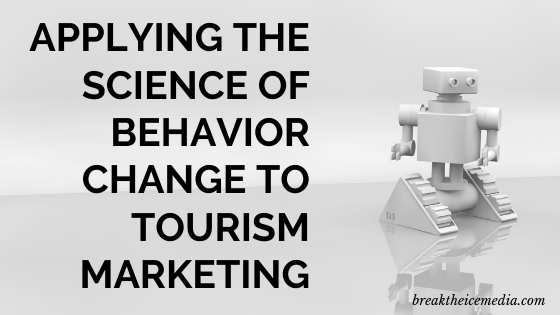Applying the Science of Behavior Change to Tourism Marketing
We have been working on a sustainable marketing campaign that relies on the ability of our marketing materials to create behavior change. As with anything we undertake at Break the Ice Media, I started with research to understand the best way to inspire a change in behavior. I found a five-concept theory presented in a report on boaters’ environmental views and a six-step theory of change published by conservation organization Rare and combined them to form seven steps. Whether you are looking to inspire behavior change for a sustainable tourism initiative, a social program or a community development project, use these seven principles to guide your strategy.
Read our introduction to capacity building in communities for destination development.

1. Awareness
As with any marketing campaign, awareness is the first step. In the case of sustainable or ecological tourism, we’re raising awareness of the issues in addition to raising awareness of the brand or program. Awareness stems not only from reach, impressions and the frequency of a message, but also the clarity and simplicity of the message.
2. Why?
Add in reasons why the issues are a concern. Inform consumers on the why behind the initiative to gain their buy-in. Beyond being aware, now they are included in the information they need to understand the why behind the issue. It’s also an opportunity to impart a feeling of goodwill by bringing them into a greater cause.
3. Demonstrate the impact
If we’re trying to change behaviors, then there are measurable impacts to the behaviors we don’t want. The cost of inaction is what we need to convey at this step. Provide real examples!
4. Shareability
Create messaging that allows easy sharing and promotes discussion on social media. Involve the audience in growing your audience.
5. What
Make sure the audience knows what to do, with helpful details to make it simple. May we suggest a few #lifehacks? Break down the the actions to take to make them easy to follow, and easy to do.
6. Barrier removal
Understanding what is standing in the way of the desired behavior is a key point in behavior change. Something may be preventing people from taking action. Until we collect information and feedback from the audience, we may never know what those things are. If direct feedback isn’t possible, set up measurement and tracking in a way that you can make an educated guess. Better yet, participate yourself or create a focus group with your team or colleagues who can give you feedback.
7. Make a difference
Show people that they are making a difference when they participate. Share some or all of your analytics in a public, meaningful way that encourages people to continue. It can also encourage new people to engage.
In the end, consumers need more than information; they need to understand the issues, the tools to share, simple steps to action and proof their actions made a difference.
Related Posts
